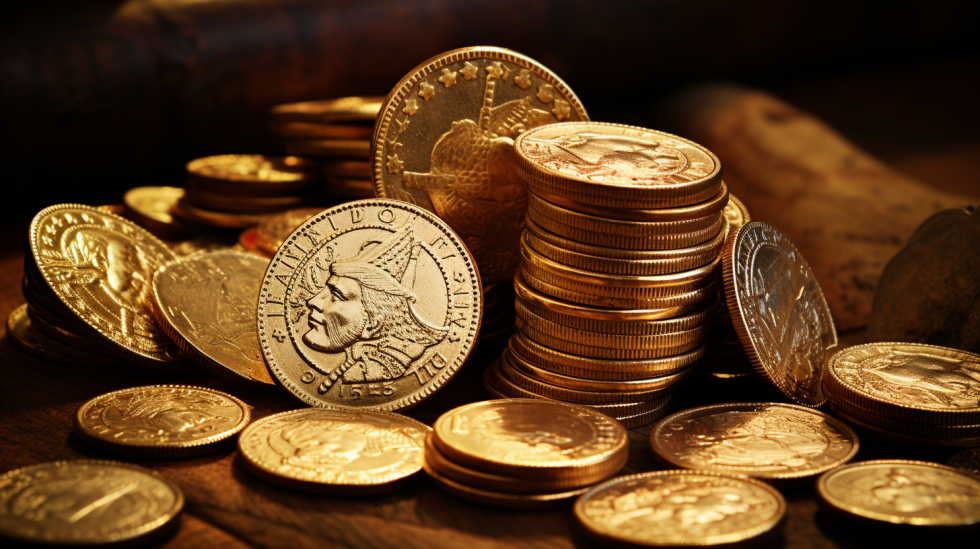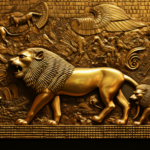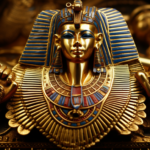Gold coins are not just pieces of currency; they are tangible expressions of power, culture, and history. Throughout antiquity, various civilizations minted gold coins that represented the apex of their artistic and economic achievements. These coins were more than just a means of exchange; they were symbols of prestige, sovereignty, and civilization itself. In this exploration of “Gold Coins of Antiquity,” we will journey through time to discover some of the most remarkable gold coins from ancient civilizations, their significance, and their lasting legacy.

The Birth of Coinage
The history of coinage, including the minting of gold coins, is a fascinating journey that spans millennia. The concept of coins as standardized currency emerged independently in various parts of the ancient world. Here are some key milestones in the birth of coinage:
1. Lydian Stater: The Lydian civilization, located in ancient Anatolia (modern-day Turkey), is often credited with producing the world’s first standardized gold coin, known as the Lydian stater, around the 7th century BCE. These coins featured a lion’s head design and set the template for future coinage.
2. Greek Drachma: The ancient Greeks developed their own coinage system, including the gold drachma, which became widely used in the Mediterranean region. Greek gold coins featured depictions of gods, heroes, and symbols of their city-states.
3. Persian Daric: The Achaemenid Empire, under the rule of King Darius I, introduced the Persian daric, a gold coin that featured the king’s portrait and an image of the Zoroastrian fire altar. These coins were used for trade and taxation.
4. Roman Aureus: The Roman Republic and later the Roman Empire issued the aureus, a gold coin that featured portraits of emperors and important figures. The aureus remained in circulation for centuries, symbolizing the might of Rome.
Gold Coins of the Ancient World
1. The Gold Staters of King Croesus (c. 550 BCE)
- Origin: Lydia (Ancient Anatolia)
- Significance: These are among the earliest standardized gold coins known to humanity. They featured a lion and bull design and were widely used in trade.
King Croesus of Lydia is often credited with minting the world’s first standardized gold coins, the Lydian staters. These coins, made of electrum (a naturally occurring alloy of gold and silver), featured a lion and bull design and became the model for later coinage.
2. The Athenian Owl (c. 510-38 BCE)
- Origin: Athens (Ancient Greece)
- Significance: The Athenian owl tetradrachm, featuring the owl of Athena on one side and an olive sprig on the other, was one of the most recognized coins of antiquity. It symbolized Athens’ cultural and economic influence.
The Athenian owl tetradrachm, minted in the city-state of Athens, is an iconic example of ancient Greek coinage. These coins featured the owl, a symbol of wisdom associated with the goddess Athena. The reverse side often depicted an olive sprig, symbolizing peace.
3. The Macedonian Stater of Philip II (c. 359-336 BCE)
- Origin: Macedonia (Ancient Greece)
- Significance: The gold staters of Philip II of Macedon featured a powerful depiction of the god Apollo on horseback. They were influential in uniting Greece under Macedonian rule.
Philip II of Macedon, father of Alexander the Great, introduced gold staters featuring the god Apollo on horseback. These coins played a role in Philip’s efforts to consolidate power and unite the Greek city-states under Macedonian leadership.
4. The Persian Daric (c. 6th-4th century BCE)
- Origin: Achaemenid Empire (Ancient Persia)
- Significance: The Persian daric was a standardized gold coin that featured the image of the Persian king and the Zoroastrian fire altar. It was widely used in trade.
The Achaemenid Empire, under the rule of King Darius I, introduced the Persian daric, a gold coin that featured the king’s portrait and an image of the Zoroastrian fire altar. These coins were used for trade and taxation.
5. The Roman Aureus (c. 1st century BCE – 4th century CE)
- Origin: Roman Republic and Empire
- Significance: The aureus was the primary gold coin of the Roman Empire, featuring portraits of emperors and symbols of Rome’s power and authority.
The Roman aureus was the primary gold coin of the Roman Republic and Empire. These coins featured portraits of emperors, gods, and important figures, making them powerful symbols of Roman authority and prestige.
6. The Gupta Dinara (c. 4th-6th century CE)
- Origin: Gupta Empire (Ancient India)
- Significance: The Gupta dinara is considered one of the most beautiful gold coins of antiquity. They featured intricate designs, including depictions of rulers, gods, and symbols of prosperity.
The Gupta Empire in ancient India is renowned for its exquisite gold coins, known as dinaras. These coins are celebrated for their intricate designs, which often featured the ruling monarch on the obverse and various Hindu deities and symbols of prosperity on the reverse. The Gupta dinara is considered a masterpiece of Indian numismatics and is highly sought after by collectors.
7. The Byzantine Solidus (c. 4th-7th century CE)
- Origin: Byzantine Empire (Eastern Roman Empire)
- Significance: The solidus was the main gold coin of the Byzantine Empire and played a crucial role in the Byzantine economy. It featured images of emperors and religious symbols.
The Byzantine Empire, the continuation of the Eastern Roman Empire, minted the solidus as its primary gold coin. These coins featured portraits of emperors, often depicted with a cross or other religious symbols. The solidus was renowned for its consistent weight and purity and remained in circulation for centuries.
The Significance of Gold Coins
Gold coins of antiquity held immense significance beyond their economic value. They were powerful symbols of the cultures and empires that minted them. Here are some key aspects of their significance:
1. Expressions of Power: Gold coins often featured the likenesses of rulers and deities, emphasizing the authority and prestige of those in power. They were a tangible expression of a ruler’s sovereignty.
2. Cultural Identity: The designs and symbols on gold coins reflected the cultural identity and values of the civilizations that minted them. They conveyed religious beliefs, artistic styles, and national pride.
3. Economic Stability: The use of standardized gold coins facilitated economic stability and trade. People could rely on the consistent value and purity of these coins for transactions.
4. Artistic Achievements: Gold coins served as canvases for artistic expression. The intricate designs and craftsmanship showcased the artistic achievements of their respective civilizations.
5. Legacy: Gold coins of antiquity have left a lasting legacy. They are sought after by collectors and historians alike, providing insights into the history, art, and culture of ancient civilizations.
The Legacy of Gold Coins
The legacy of gold coins of antiquity extends far beyond the civilizations that minted them. These coins have left indelible marks on the fields of numismatics, history, and art. Here are some ways in which the legacy of gold coins endures:
1. Numismatic Study: Gold coins from antiquity are invaluable to numismatists—scholars who study coins. They provide insights into ancient economies, trade networks, and the evolution of coinage.
2. Artistic Inspiration: The designs and motifs on ancient gold coins continue to inspire contemporary artists and designers. Elements of these designs are often incorporated into modern art, jewelry, and decorative objects.
3. Cultural Heritage: Gold coins are a part of the cultural heritage of the regions where they were minted. They serve as reminders of the rich histories and achievements of ancient civilizations.
4. Museum Collections: Museums around the world house extensive collections of ancient gold coins. These exhibits allow people to appreciate the artistry and historical significance of these coins.
5. Collectors’ Treasures: Gold coins from antiquity are highly sought after by collectors. Some rare and well-preserved coins can fetch astronomical prices in the collectors’ market.
Conclusion: Treasures of the Past
Gold coins of antiquity are more than just relics of the past; they are treasures that connect us to the civilizations that preceded us. These coins represent the aspirations, achievements, and artistry of ancient cultures, and they continue to captivate us with their beauty and historical significance.
As we gaze upon the intricate designs and timeless beauty of these coins, we are reminded of the enduring allure of gold and its role in shaping human history. Gold coins are not just artifacts; they are windows into the past, allowing us to glimpse the wealth, power, and cultural riches of the ancient world.
In the hands of rulers and merchants, artisans and collectors, gold coins of antiquity have journeyed through time, leaving their indelible mark on the annals of history. They are not just currency; they are symbols of human achievement and the enduring quest for beauty, knowledge, and legacy.



